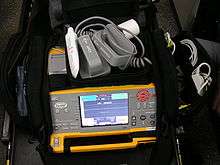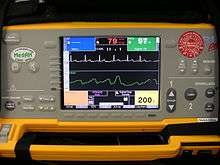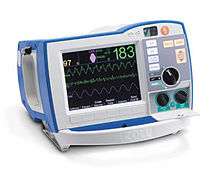Cardiac monitoring
Cardiac monitoring generally refers to continuous or intermittent monitoring of heart activity, generally by electrocardiography, with assessment of the patient's condition relative to their cardiac rhythm. It is different from hemodynamic monitoring, which monitors the pressure and flow of blood within the cardiovascular system. The two may be performed simultaneously on critical heart patients. Cardiac monitoring with a small device worn by an ambulatory patient (one well enough to walk around) is known as ambulatory electrocardiography (such as with a Holter monitor, wireless ambulatory ECG, or an implantable loop recorder). Transmitting data from a monitor to a distant monitoring station is known as telemetry or biotelemetry.
| Cardiac monitoring | |
|---|---|
| Medical diagnostics | |
Cardiac monitoring in the ED setting has a primary focus on the monitoring of arrhythmia, myocardial infarction, and QT-interval monitoring. It is a noninvasive diagnostic tool and monitoring is categorized by the rating system developed by the American College of Cardiology Emergency Cardiac Care Committee.
The different classes are as follows:
Class I: Cardiac monitoring is indicated in all or most patients.
Class II: Cardiac monitoring may be beneficial, but it is not essential.
Class III: Cardiac monitoring is not indicated because the patient's serious event risk is low. Monitoring will not have therapeutic benefit.[1]
Emergency medical services
In the setting of out-of-hospital acute medical care, ambulance services and other emergency medical services providers utilize heart monitors to assess the patient's cardiac rhythm. Providers licensed or certified at the Paramedic level are qualified to interpret ECGs. Information obtained from ECGs can then be used to direct the patient's treatment at a care facility, particularly in catheterization labs.[2]
In the emergency department
In the emergency department, cardiac monitoring is a part of the monitoring of vital signs in emergency medicine, and generally includes electrocardiography.
Monitor/Defibrillators
Some digital patient monitors, especially those used EMS services, often incorporate a defibrillator into the patient monitor itself. These monitor/defibrillators usually have the normal capabilities of an ICU monitor, but have manual (and usually semi-automatic AED)defibrillation capability. This is particularly good for EMS services, who need a compact, easy to use monitor and defibrillator, as well as for inter- or intrafacility patient transport. Most monitor defibrillators also have transcutaneous pacing capability via large AED like adhesive pads (which often can be used for monitoring, defibrillation and pacing)that are applied to the patient in an anterior-posterior configuration. The monitor defibrillator units often have specialized monitoring parameters such as waveform capnography, invasive BP, and in some monitors, Masimo Rainbow SET pulse oximetry. Examples of monitor defibrillators are the Lifepak 12, 15 and 20 made by Physio Control, the Philips Heartstart MRx, and the E, R, and X Series by ZOLL Medical.
 A Welch Allyn PIC 50 monitor/defibrillator from an Austrian EMS service. |  A closeup view of the screen of the PIC 50. |  ZOLL R Series Plus external monitor/defibrillator |
Long-term ambulatory monitors
There are two broad classifications for cardiac event monitors: manual (or dumb) and automatic. Automatic ECG event monitors have the ability to monitor the patient's ECG and make recordings of abnormal events without requiring patient intervention. Manual ECG event recorders require the patient to be symptomatic and to activate the device to record an event; this makes these devices useless whilst, for example, the patient is sleeping. A third classification, the implantable loop recorder, provides both automatic and manual abilities.
An example of automatic monitoring is the transtelephonic cardiac event monitor. This monitor contacts ECG technicians, via telephone, on a regular basis, transmitting ECG rhythms for ongoing monitoring. The transtelephonic cardiac event monitor can normally store approximately five "cardiac events" usually lasting 30–60 seconds.
 Portable wireless ECG monitor
Portable wireless ECG monitor A close up of a person wearing the iRhythm ZIO XT patch, nine days after its placement
A close up of a person wearing the iRhythm ZIO XT patch, nine days after its placement
Heart rate monitoring
Monitoring of the heart rate can be performed as part of electrocardiography, but it can also be measured conveniently with specific heart rate monitors. Such heart rate monitors are largely used by performers of various types of physical exercise.
A generic cardiac monitor has the following functions:
- A display of heart rate and heart rhythm
- Sound alarms above and below a pre-set limit
- Ability to determine the presence of arrhythmia
There are many different types of cardiac monitors. In personal use, the Holter monitor is an external monitor which uses wires with patches that attach to the skin to continuously measure and record heart activity for 1–2 days.[3] An Event Recorder can be worn on the body for up to 30 days.[4] A Mobile Cardiac Telemetry unit is a wearable monitor that detects, records, and transmits heart rhythms for up to 30 days. For long term use, an Insertable Cardiac Monitor is placed under the skin and automatically detects and records abnormal heart rhythms for up to 5 years.[5]
Fetal Heart Rate Monitoring
Monitoring the fetal heart rate is becoming increasingly prevalent in the standard care of antepartum pregnant patients.[6] As of 2002, 85% of pregnancies in the United States were monitored using electronic fetal monitoring. Electronic fetal monitoring uses Doppler ultrasound technology to provide real-time feedback on the fetus’s cardiac activity during both gestation and labor.[7]
Wearable Heart Rate Monitors for Exercise
The new wearable heart rate monitors indirectly measure the heart rate with reflectance photoplethysmography. The monitor illuminates the skin tissue with light emitting diode (LED) and detects the intensity of light reflected with the photodetector.[8] Wearable optical heart rate monitors are less reliable than electrode-based heart rate monitors. The accuracy of the wearable optical heart rate monitors varies with the type of exercise. Skin tone and motion artifacts contributes to this error.[8][9]
Insurance Coverage
There are two types of cardiac monitoring that is covered by Medicare:
- Ambulatory electrocardiography (AECG): includes cardiac monitoring that is situated in an outpatient setting during a specific period. AECG devices are different from other cardiac monitoring tools as they can be used to determine specific incidences of arrhythmia, which is not typically detected using a standard ECG. Therefore, the AECG devices are typically used to identify and determine the severity of symptoms associated with cardiac arrhythmia's and/or myocardial ischemia. AECG devices are typically conducted by independent diagnostic testing facilities (IDTFs).
- Transtelephonic monitoring of cardiac pacemakers (CPT code 93293): monitoring of cardiac pacemakers are necessary to ensure the quality and condition of pacemakers and identify any potential drawbacks or signs of pacemaker failure, which reduces the possibility of sudden pacemaker failures[10]
References
- Zègre-Hemsey, Jessica K.; Garvey, J. Lee; Carey, Mary G. (September 2016). "Cardiac Monitoring in the Emergency Department". Critical Care Nursing Clinics of North America. 28 (3): 331–345. doi:10.1016/j.cnc.2016.04.009. ISSN 0899-5885. PMC 5630152. PMID 27484661.
- Blackwell, Thomas H. (2018). Rosen's Emergency Medicine: Concepts and Clinical Practice. New York City, New York: Elsevier. pp. 2389–2397. ISBN 9780323390170.
- "Holter Monitor". www.heart.org. Retrieved 2019-08-29.
- "Cardiac Event Recorder". www.heart.org. Retrieved 2019-08-29.
- "Insertable Cardiac Monitor; Cardiology & Heart Care". Orange Regional Medical Center. Retrieved 2019-08-29.
- Mehta, Shobha; Sokol, Robert (2019). "Assessment of At-Risk Pregnancy" In: CURRENT Diagnosis & Treatment: Obstetrics & Gynecology. New York, NY: McGraw-Hill.
- Murray, Henry (2017-01-01). "Antenatal foetal heart monitoring". Best Practice & Research Clinical Obstetrics & Gynaecology. Antenatal Fetal Surveillance. 38: 2–11. doi:10.1016/j.bpobgyn.2016.10.008. ISSN 1521-6934. PMID 27866937.
- Preejith, S P; Alex, Annamol; Joseph, Jayaraj; Sivaprakasam, Mohanasankar (May 2016). "Design, development and clinical validation of a wrist-based optical heart rate monitor". 2016 IEEE International Symposium on Medical Measurements and Applications (MeMeA). Benevento, Italy: IEEE: 1–6. doi:10.1109/MeMeA.2016.7533786. ISBN 9781467391726.
- Gillinov, Stephen; Etiwy, Muhammad; Wang, Robert; Blackburn, Gordon; Phelan, Dermot; Gillinov, A. Marc; Houghtaling, Penny; Javadikasgari, Hoda; Desai, Milind Y. (August 2017). "Variable Accuracy of Wearable Heart Rate Monitors during Aerobic Exercise". Medicine & Science in Sports & Exercise. 49 (8): 1697–1703. doi:10.1249/MSS.0000000000001284. ISSN 0195-9131. PMID 28709155.
- Rheuban, Karen; Krupinski, Elizabeth A. (2017-12-22). Understanding telehealth. Rheuban, Karen S.,, Krupinski, Elizabeth A. New York. ISBN 9781259837418. OCLC 1004670286.